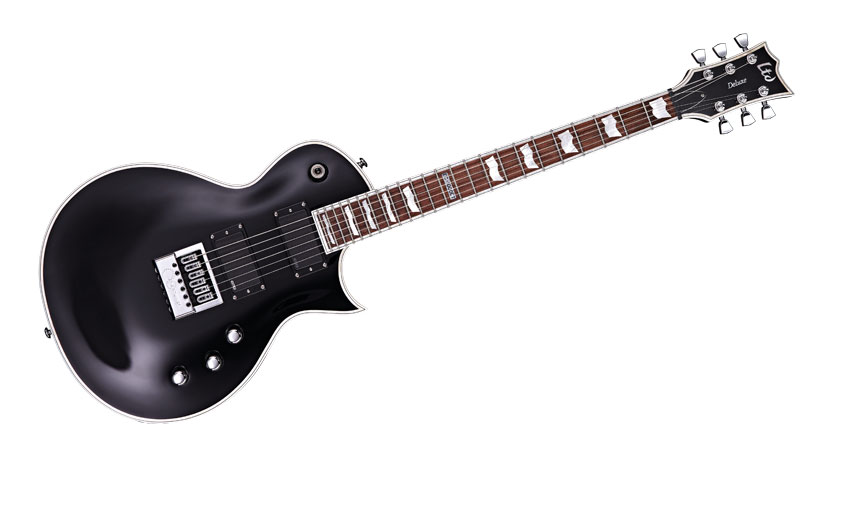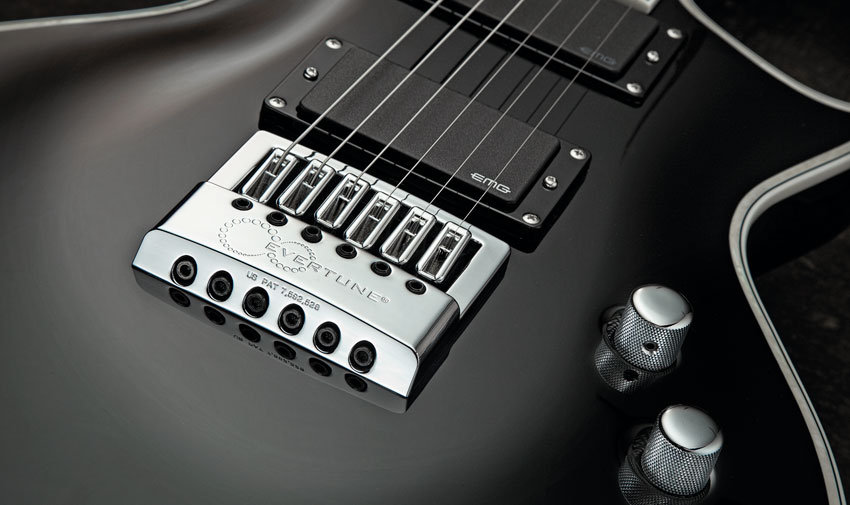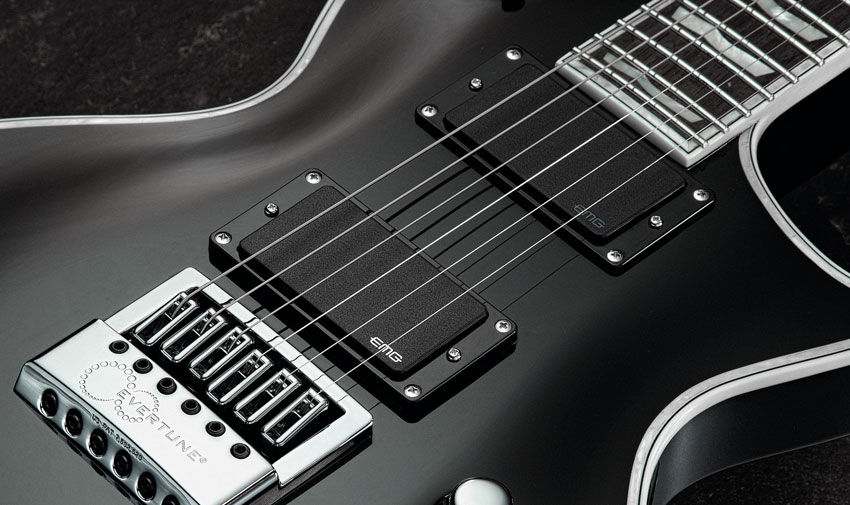MusicRadar Verdict
EverTune actually works, increasing the musicality of you and your guitar at a stroke.
Pros
- +
Great metal and rock guitar. No tangible tone compromises from the bridge. Unobtrusive EverTune bridge design.
Cons
- -
It's complex to get to grips with initially. Retrofitting one is a pro job.
MusicRadar's got your back

LTD EC-1000 EverTune

Bridge

Pickups

Rear
Stable tuning is without doubt a fundamental requirement for guitars and basses. Over the years there have been both mechanical and digital helping hands to keep the ol' stick on song, and indeed throw in near-instant access to altered tunings to boot. Gibson's latest offering, the Min-ETune is the current leader in the mechanical tuning world, while Peavey's AT-200 is the best of the digital crop.
However, here is a system that has its roots not in ones and noughts, nor mini motorised tuners, but in good old mechanics alongside a hefty helping of A-level physics and trigonometry. It's hoping to be a genuine panacea to all tuning woes. Sounds improbable?
"Unlike other systems, it doesn't tune your guitar for you. Instead, once tuned, it simply aims to stay there"
Well, that's what we thought when we first read about the EverTune bridge, which has been available for a little while as a pro-install retrofit item. Unlike other systems, it doesn't tune your guitar for you or offer altered tunings. Instead, once set and tuned, it simply aims to stay there.
For 2013, ESP has launched two models into the Korean-made LTD Deluxe electric guitar range pre-fitted with the EverTune 'F model' bridge. EverTune itself has a number of differing models available, for seven-and eight-string guitars, for Telecaster styles and for retrofitting onto a Les Paul. But back to the unit in hand...
Vibrato bridges - be they the traditional Fender system or a double-locking Floyd Rose - function by balancing the pull of the strings with springs set into a cavity on the rear of the guitar. If the bridge is correctly set up and your strings are stretched out, you can pull off subtle vibratos and swooping divebombs with no loss of tuning, in theory at least.
This is familiar territory, but as anyone who has upped their gauge of string (and thus the strength of the pull) will know, finding the balance point is tricky if you want the bridge to have any upward movement. "Hang on," we hear you cry, "this guitar doesn't have a vibrato..."
Nope, but the balancing act we've just described is the basic principle behind EverTune. The concept is fairly simple: each string has its own spring and lever, and it's the individual saddles that move back and forth when the pull is increased, rather than the entire bridge assembly. From here, proceedings become less familiar.
To start, you need to assign the tuning intervals themselves so the array can maintain the balance in tensions, and you do this by adjusting each string's spring using a 2.5mm hex key, not the machineheads. So, if you wish your guitar to be in standard 440Hz tuning you need to set each saddle so that it not only rocks back and forth within what EverTune calls Zone 2, but that it's actually in tune, too.
"It does require a larger aperture than normal, so that means significant woodwork if you want to retrofit one"
It sounds fiddly, but it's less of a chore than restringing a guitar set up with a floating Floyd. The theory is that, once the guitar is in tune, there it'll stay, come what may. The aluminium bridge that includes the six steel saddles sits flush to the guitar's top, but most of the array lies within a back cavity. It does require a larger aperture than normal, certainly larger than that of a Strat's vibrato, so that means significant woodwork to your guitar if you want to retrofit one.
Intonation and string height can be adjusted via two rows of screws, using the same 2.5mm Allen key, and EverTune has also included a dampening system to ensure that the springs themselves don't rattle.
Aside from when restringing, the machineheads don't have a traditional modus operandi: remember that, once you're in pitch, EverTune says you'll never need to adjust the tuning. Instead, you can use them to alter the sensitivity of the system. By tightening the relevant tuner, you can set the 'butteriness' of the feel, and you can even have it so the string doesn't alter in pitch, even if you do bend it. Bizarre though that sounds, there are a couple of instances where it could be to your advantage. Firstly, for jazz players, perhaps, where you want bang-on note precision every time.
Secondly, when tracking guitars for recording, compromises in intonation caused by uneven pressure applied by your fingers are evened out automatically: neat! Double and triple-tracked rock guitar parts happen so much more quickly, simply because everything is locked in tune.
As for the EC-1000ET itself, the guitar is an all-mahogany single-cut loaded with an set of EMG 81 and 60 active humbuckers, a comfortably modern neck and a high level of construction quality. It's not noticeably heavier when strapped on because quite a lot of body wood needs to be removed to install the 0.58kg EverTune bridge and, fortunately, as the entire system depends on this, the setup is spot on out of the box.
In Use
So, does it work: does it actually keep the guitar in tune? The answer is a yes, albeit with a couple of caveats...
"We tried everything we could to knock it out of whack... we even put the guitar into a freezer"
We tried everything we could to knock it out of whack: huge, three-step bends, wildly exaggerated string stretching... we even put the guitar into a freezer. It came back perfectly in tune every single time.
What's more, a guitar that's perfectly tuned and intonated up and down the neck seems to play much more musically. It's probably not something you'd want to measure, but this writer would agree with our editor-in-chief and reviews editor's comments after they played prototypes at NAMM 2012: something about the feel makes you want to just keep on playing. For example, arpeggiated chords above the 12th fret are perfectly in tune with the open bass strings, and even the most obscure chord inversions sound musical.
We're not aware of any tone compromises, either. The EC sounds as full and aggressive as ever, with the more mellow tones of the neck EMG being pleasantly rounded, and all bereft of any metallic spring clank. You might even argue that there are resonant benefits on certain guitars.
The EverTune system does have one significant, deal-breaking downside as a retrofit item, and that's that it requires a skilled person to make a big, permanent mod to your beloved guitar: very few people are really up for that. It's good news, then that LTD has chosen to produce models that come with the system factory-fitted: a simple way of trying it out for yourself, and perhaps falling in love with the host in the process.
Once your brain deals with what's happening, the EverTune seems a pretty solid concept, and there's no doubt it keeps your guitar perfectly in tune once settled in. We'd recommend that absolutely everybody gives it a try!
- More of the best metal guitars
Simon Bradley is a guitar and especially rock guitar expert who worked for Guitarist magazine and has in the past contributed to world-leading music and guitar titles like MusicRadar (obviously), Guitarist, Guitar World and Louder. What he doesn't know about Brian May's playing and, especially, the Red Special, isn't worth knowing.
"That's what it takes to make music that's gonna last forever": Olivia Rodrigo and Chappell Roan producer Daniel Nigro on crafting timeless tracks
“A fully playable electro-mechanical synth voice that tracks the pitch of your playing in real time”: Gamechanger Audio unveils the Motor Pedal – a real synth pedal with a “multi-modal gas pedal”
“It was the first rock monster that we'd created”: How an explosive 2001 switch-up revealed just how ferocious Muse could get









